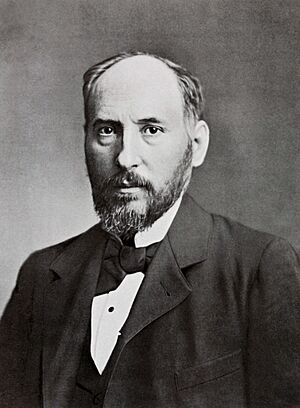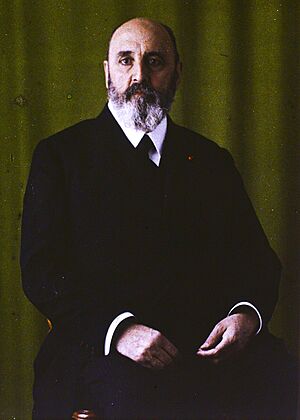Science and technology in Spain facts for kids
Science and technology in Spain is all about the plans and programs Spain uses to boost research, development, and new ideas (R&D&I). It also focuses on making Spain's science and tech places, like universities and labs, even better.
Spain is a strong player in science globally, ranking ninth in the world for scientific publications. This means Spanish scientists publish a lot of important research! Spain also does well in the quality of its science, even beating countries like Switzerland and Australia in some areas.
Contents
Rules for Science in Spain
The First Science Law (1986)
The "Science Law" of 1986 was a big step for Spain. It was the first time science became a main focus for the government. This law set up how research would be funded and organized across the country. It also allowed public research groups to create new companies. This helped connect science with new technologies and businesses.
The Science, Technology, and Innovation Law (2011)
This law, from 2011, updated the rules for science in Spain. It helps national and regional groups work together and use their resources in the best way. It also includes rules for things like pre-doctoral contracts, which help students get ready for advanced research.
The Science Law (2022)
A newer Science Law was approved in 2022. This law gave more freedom to important research groups like the State Research Agency (AEI) and the Spanish National Research Council (CSIC). They now have more control over their own budgets, which helps them manage their research better.
How Science Gets Money
In 2020, Spain spent about 1.24% of its total money (GDP) on science research. This is less than the average for Europe, which is around 2.12%.
Big Plans for Science
Spain has created several "National R&D&I Plans" over the years. These are like big roadmaps for science and technology. The latest plan covers the period up to 2020.
Every year, a special "Work Program" is approved. This program helps guide short-term science projects and is managed by different government ministries, including the Ministry of Science and Innovation.
In late 2020, the Spanish government also launched its "Digital Plan 2025." This plan aims to use science and technology to help Spain's economy grow and become stronger. A key part of this plan is creating a safe place for companies to test new AI systems, especially for important areas like law enforcement and medical help.
There's also a cool project called "Nanoinventum." It's led by the University of Barcelona and teaches kids in elementary school about science and nanotechnology. The goal is to get young people excited about science and new technologies.
Main Research Groups
Many research activities in Spain are done by "Public Research Organizations" (OPIs). These groups get money from the government and often manage parts of the National Plans.
Some important OPIs that work with the Ministry of Science and Innovation include:
- Spanish National Research Council (CSIC).
- Center for Energy, Environmental and Technological Research (CIEMAT).
- Geological and Mining Institute of Spain (IGME).
- Spanish Institute of Oceanography (IEO).
- Institute of Astrophysics of the Canary Islands (IAC).
Other OPIs work with different government departments, such as:
- Carlos III Health Institute (ISCIII).
- National Geographic Institute (IGN).
- State Meteorological Agency (AEMET).
- National Institute of Aerospace Technology (INTA).
Special Science Places in Spain
Spain has some very special and important science facilities. These are called "Singular Scientific and Technical Infrastructures" (ICTS). They are unique, cost a lot to build, and are super important for research.
Some examples of these special places are:
- Spanish Antarctic Bases.
- Oceanographic Research Vessel Hespérides (a research ship).
- Yebes Astronomical Center.
- MareNostrum and MinoTauro supercomputers at the National Supercomputing Center.
- Almeria Solar Platform (for solar energy research).
- ALBA Synchrotron Light Laboratory (a powerful light source for science).
- Oceanic Platform of the Canary Islands.
Spain also has ICTS that are part of international projects, like:
- Calar Alto Astronomical Center.
- Teide Observatory.
- Roque de los Muchachos Observatory.
- Gran Telescopio Canarias (a very large telescope).
Spanish Scientists in Other Countries
Spain also takes part in many international science programs and organizations. This means Spanish scientists can use amazing facilities around the world, and Spanish companies can get important contracts.
Some of these international groups include:
- European Space Agency (ESA).
- CERN (the European organization for nuclear research).
- European Molecular Biology Laboratory (EMBL).
- European Synchrotron Radiation Facility (ESRF).
Amazing Discoveries and Inventions from Spain
Spain was ranked 28th in the world for new ideas and inventions in 2024.
Physics
Spanish physicists have made big contributions. For example, Pablo Jarillo-Herrero won the Wolf Prize in Physics in 2020, which is a very important award. Juan Ignacio Cirac was also nominated for the same award for his work on quantum computing.
Chemistry
In chemistry, Francisco Mojica's research led to the amazing CRISPR gene editing technique. This allows scientists to make precise changes to DNA. Mariano Barbacid is another famous biochemist who helped understand how cancer develops. He now leads the Spanish National Cancer Research Centre (CNIO).
Mathematics
Spain is strong in mathematics, ranking seventh globally for its scientific impact in this field in 2020. Important centers like the Institute of Mathematical Sciences (ICMAT) and the Basque Center for Applied Mathematics (BCAM) are based in Spain.
Medicine
Spanish doctors have a long history of important discoveries:
- In the 16th century, Michael Servetus described how blood flows through the lungs.
- In 1801, Francisco Romero performed the first heart operation.
- Santiago Ramón y Cajal won the Nobel Prize in Medicine in 1906 for his groundbreaking work on the nervous system.
- Jaime Ferrán y Clúa discovered the cholera vaccine, which saved many lives in the 19th century. He also developed vaccines for tetanus, typhoid, and rabies.
- The Balmis Expedition in 1803 was the first international health mission ever. Its goal was to bring the smallpox vaccine to people all over the world.
- In 1921, Fidel Pagés developed the epidural anesthesia technique, used widely today.
- Manuel Jalón Corominas invented the disposable hypodermic needle.
- Today, Pedro Cavadas is known internationally for his amazing work in transplant surgery.
Engineering
Spain has a rich history of engineering inventions:
- The galleon, a type of large sailing ship, was a Spanish invention that helped Spain explore the world.
- Narcís Monturiol and Isaac Peral were among the inventors of the submarine.
- Juan de la Cierva invented the autogyro, which was a very early type of helicopter.
- In 1907, Leonardo Torres Quevedo built the world's first aerial lift for passengers in San Sebastián.
Biology and Biotechnology
In biotechnology, Spain has important groups like the National Biotechnology Center and companies like PharmaMar. Researchers like Mariano Esteban are also making big advances.
Nuclear Energy
Spain has nuclear reactors that produce energy. The main research center for nuclear energy in Spain is the Center for Energy, Environmental and Technological Research (CIEMAT). They have a special device called the TJ-II stellarator, which is used to study nuclear fusion.
Computer Science
Hardware and Electronics
- Ramón Verea created the first mechanical calculator that could multiply directly.
- Leonardo Torres Quevedo (1852–1936) developed modern wireless remote-control ideas and machines that could solve math problems. In 1912, he built a chess-playing machine, El Ajedrecista, which is seen as the first computer game.
- José García Santesmases (1907–1989) built Spain's first analog computer and its first microprocessor.
- Today, Spanish companies like Primux, Slimbook, Vant, and Mountain design and assemble their own computers in Spain.
Software
Between 1983 and 1992, Spain was a major producer of video games, a time known as the "golden age of Spanish video games."
Internet
In the late 1990s, IRC-Hispano was a popular online community. Other successful Spanish internet companies include Terra Networks and Tuenti. Today, companies like Wallapop, Fotocasa, Cabify, and Rakuten TV are well-known.
Space
Spain has a long history with space and astronomy.
- Astronomers like Alonso de Santa Cruz helped improve how ships navigated using the stars.
- Since 1968, the National Institute for Aerospace Technology has worked on scientific satellite programs.
- Many instruments for space missions to Mars and asteroids are developed at the Astrobiology Center (CAB).
- Important Spanish figures in space include Emilio Herrera, who invented an early version of the space suit, and Pedro Duque, the first Spanish astronaut.
Science and Technology Parks
Spain has many "science and technology parks." These are special areas where research centers, universities, and tech companies are grouped together to work on new ideas. They are often part of the Association of Science and Technology Parks of Spain (APTE).
Some examples of these parks include:
- León Technology Park.
- Alava Technology Park.
- Barcelona Science Park.
- 22@Barcelona.
- Galicia Technology Park.
- Granada Health Sciences Technological Park.
- Madrid Science Park.
- Andalusia Technology Park (PTA) in Malaga.
- Cartuja 93 Science and Technology Park in Seville.
- València Technology Park.
International Science Programs
Spain is involved in many international R&D&I programs, especially in Europe. These programs help Spanish scientists and businesses work with others around the world.
Some key programs include:
- The Framework Program of the European Union, which supports R&D&I.
- European Space Agency (ESA), where Spain helps with space research and technology.
- CERN, the European organization for nuclear research.
- Global Biodiversity Information Facility, an international program to study global biodiversity.
Learning About Science
The Spanish Foundation for Science and Technology (FECYT) is a public group that helps bring science and new ideas closer to society. The National Museum of Science and Technology (MUNCYT) is a great place to learn about science and technology. It has two locations, one in Alcobendas and another in A Coruña.
See also
- History of science and technology in Spain
- Open access in Spain
- Women in STEM fields
- Spanish Inventions
- Spanish Inventors
- Ministry of Science and Innovation



